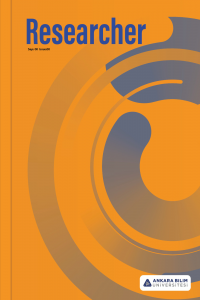Point Counter Point Ses Sese Karşı ve Saatleri Ayarlama Enstitüsü’nde Sosyal ve Ahlaki Yozlaşma ve Kültürel Bellek
Bu çalışmanın amacı Ahmet Hamdi Tanpinar’ın Saatleri Ayarlama Enstitüsü 1961 ve Aldous Huxley’nin Ses Sese Karşı Point Counter Point 1928 eserlerinde sosyal ve ahlaki yozlaşmanın nasıl sunulduğunu incelemektir. Aldous Huxley, Ses Sese Karşı adlı romanında Menipusçu hiciv geleneğini kullanarak I. Dünya savaşı sonrası İngiliz toplumunda gördüğü sosyal ve siyasi yozlaşmalara dikkat çekmektedir. Romanda her bir karakter bir düşüncenin temsilcisidir. Bu nedenle her bir karakter sosyal ve ahlaki bir duruma karşılık gelmektedir. Bu nedenle bu romandaki karakterler, fikirlerin daha özgür bir söylemle kendilerini ifade etmeleri için yazarın yozlaşma olarak gördüğü şeyleri eleştirebilmesi için uygun bir ortam sunmaktadır. Tanpınar’ın Saatleri Ayarlama Enstitüsü adlı eserinde de karakterler bir sosyal ve ahlaki durumun yansımalarıdır. Tanpınar, romanında Bakhtin ve Menipus’un hiciv modelini kullanmaktadır. Romandaki kinayeli anlatı ve çağının düşüncelerinin karakterlerle temsili yazara Türk toplumunda yozlaşma olarak gördüğü şeylere okuyucusunun dikkatini çekmek için özgür bir düşünce alanı sağlamıştır. Huxley ve Tanpınar hiciv geleneğini kullanarak İngiliz ve Türk toplumunda ve İngiliz toplumunda ortaya çıkan yozlaşmaların yeniden anlatıya uyarlanmasında birbirlerine benzer bir tutum sergilemişlerdir. Bahsi geçen romanlardaki bu tutum ve yozlaşmanın örnekleri bu makalede incelenmiştir
Social and Moral Corruption and Cultural Memory in Point Counter Point and The Time Regulation Institute
This paper aims to compare how social and moral corruption is represented in Aldous Huxley’s Point Counter Point Ses Sese Karşı 1928 and Ahmet Hamdi Tanpinar’s Saatleri Ayarlama Enstitüsü The Time Regulation Institute 1961 . Writing about post WW1 England, Huxley employs the Menippean model of satire in Point Counter Point to draw our attention to the moral and political corruption he observes in English society. Characters of the novel stand for ideas, each character representing certain social and moral attitudes. Thus, they create intellectual space for the free interplay of ideas and become mouthpieces for the writer to satirize what he sees as corruption. Tanpinar’s characters in The Time Regulation Institute also embody certain social and moral manners. Tanpinar employs both the Bakhtin and the Menippean models of satire in the novel. The ironic tone and embodiment of contemporary ideas through the characters in The Time Regulation Institute provide Tanpinar a free intellectual space in the novel to draw the readers’ attention to what he sees as corruption in contemporary Turkish society. Using the Menippean satire, Huxley and Tanpinar, then, re-appropriate a similar attitude towards social and moral corruptions in English and Turkish society. This paper analyses their attitudes and ideas of corruption with reference to the novels under discussion.
___
- Bakhtin, M. (1984). Problems of Dostoevsky’s Poetics. (C. Emerson, Ed.).
- Brudevold, B. (1940). Aldous Huxley’s Use of Music in Point Counter Point. State University of Montana.
- Cushman, K. (n.d.). "I refuse to be Rampioned": Huxley, D. H. Lawrence. pp. 1–24.
- Gramm, A. (2002). Aldous Huxley‘s Point Counter Point - a modernist novel? Grosvenor, P. (1932). Progress, Elitism and Ideology in Point Counter Point as a Novel of Ideas.
- Feldman, W. (1998). Time, Memory and Autobiography in The Clock-Setting Institute of Ahmet Hamdi Tanpınar. Edebiyat, 8, 37–61. Retrieved from papers://f757ae11-b68c-4a5a-a5f4- 969e9e35f85d/Paper/p87
- Frye, N. (1973). Anatomy of Criticism: Four Essays. Princeton, New Jersey: Princeton University Press. http://doi.org/10.1007/s13398-014-0173-7.2
- Huxley, A. (1928). Point Counter Point. New York: Modern Library.
- Kaplan, M. (2002). Saatleri Ayarlama Enstitüsü. A. Uçman & H. İnci. (Ed.). Bir Gül Bu Karanlıklarda. (pp. 109-111) İstanbul: 3F Kitabevi.
- Moran, B. (2001). Türk Romanına Eleştirel Bakış: The Time Regulation Institute, (Z. Başkal, Trans.). Madison: Turco-Tatar Press. (Original work published in 1983)
- Patchett, E. (2013). Cultural Memory. Retrieved from http://www.itn-cohab.eu/wiki/culturalmemory.
- Riker, M. (2014, Jan. 3). A Ramshackle Modernity, ‘The Time Regulation Institute,’ by Ahmet
- Hamdi Tanpinar. The New York Times, Sunday Book Review. Page BR11. Retrieved from https://www.nytimes.com/2014/01/05/books/review/the-time-regulation-institute-by-ahmethamdi-tanpinar.html
- Rushdie, S. (1997). Midnight’s Children. Toronto: Vintage Canada. Tanpinar, A. H. (2014). The Time Regulation Institute (A. Dawe & M. Freely, Trans.). New York: Penguin Books.
- ISSN: 2717-9494
- Yayın Aralığı: Yılda 2 Sayı
- Başlangıç: 2013
- Yayıncı: Ankara Bilim Üniversitesi
Sayıdaki Diğer Makaleler
Tekin ÇELİKKAYA, Mutlu KÜRÜMLÜOĞLU
“WALL-E” Filminin Çevre Etiği Açısından Değerlendirilmesi
Brexit ile Diğer İç ve Dış Faktörlerin Avrupa Birliği - Türkiye İlişkilerine Etkileri
Bilginin Toplumsal Devamlılığında Dilin Rolü
Otomobil Bayii Seçim Kriterlerini Sıralamak İçin Bulanık Çok Kriterli Karar Verme Modeli Yaklaşımı
I. Dünya Savaşı Döneminde Bir İngiliz Esir Gazetesi: Afyonkarahisar
